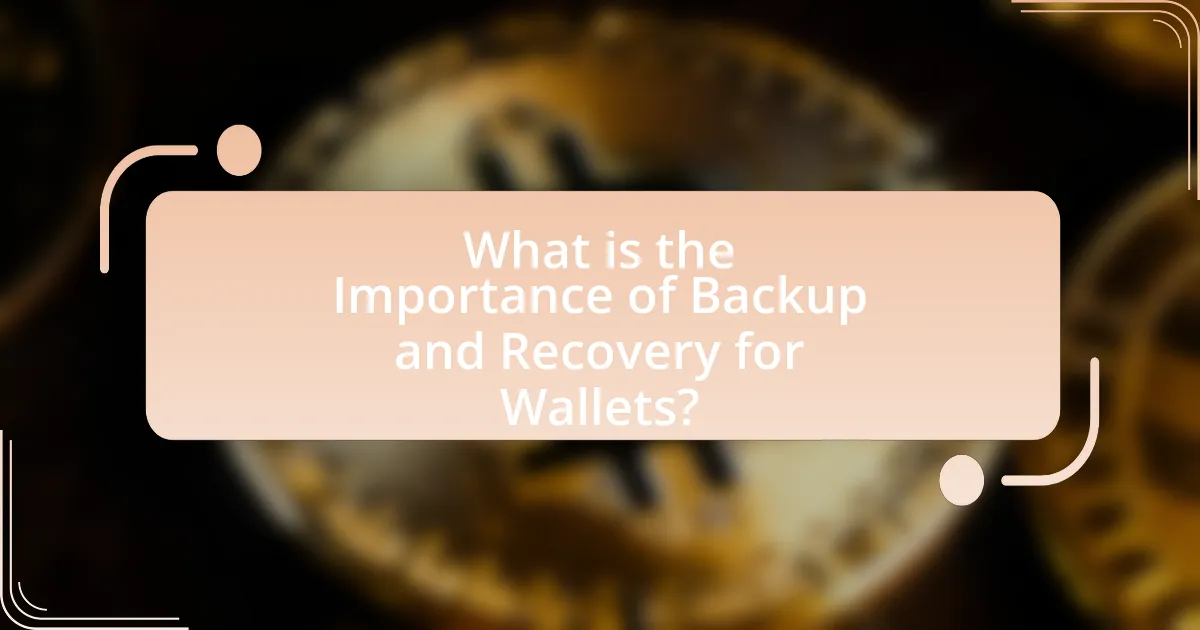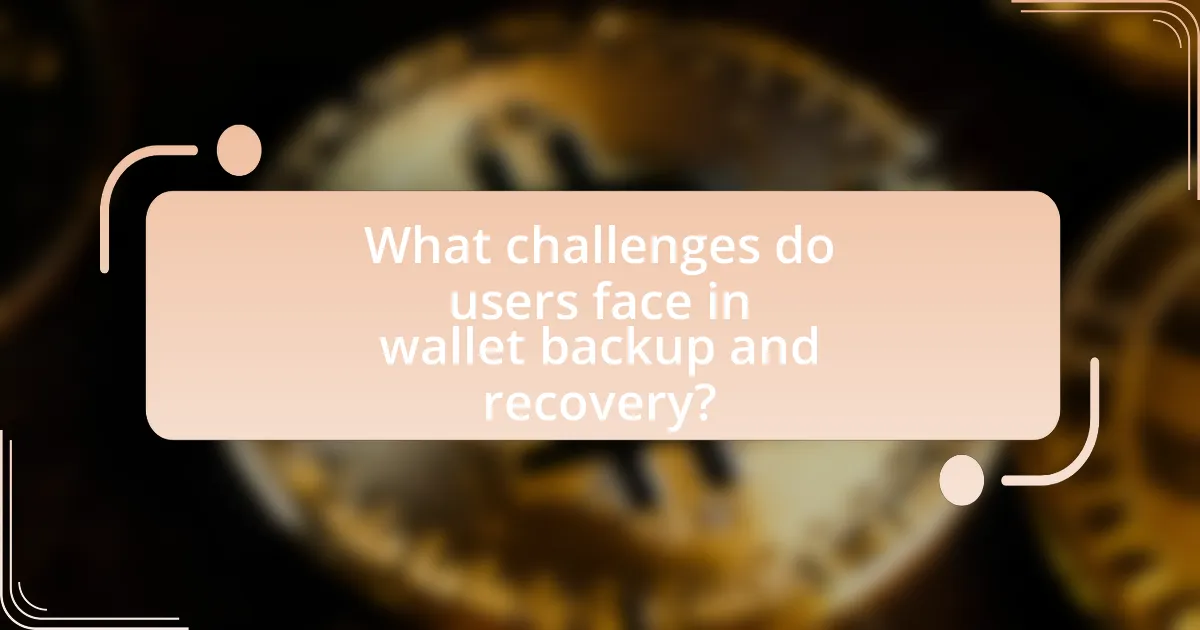The article emphasizes the critical importance of backup and recovery for digital wallets, highlighting the risks users face without proper strategies, such as permanent loss of access to funds and sensitive information. It discusses the necessity of regular backups, effective recovery methods like seed phrases and private keys, and best practices for safeguarding wallet data. Additionally, the article outlines common mistakes users make in the backup process and provides actionable steps to create a reliable backup and recovery strategy, underscoring the long-term implications of data loss on wallet users.

What is the Importance of Backup and Recovery for Wallets?
Backup and recovery for wallets is crucial because it ensures the safety and accessibility of digital assets. In the event of device loss, theft, or failure, having a backup allows users to restore their wallets and recover their funds. According to a study by the Blockchain Research Institute, approximately 20% of cryptocurrency holders have lost access to their wallets due to inadequate backup practices. This statistic highlights the necessity of implementing robust backup and recovery strategies to prevent financial loss and maintain control over digital currencies.
Why is backup essential for digital wallets?
Backup is essential for digital wallets because it protects users’ funds and transaction history from loss due to device failure, theft, or accidental deletion. Digital wallets store sensitive information, including private keys and account details, which are crucial for accessing cryptocurrencies and other digital assets. Without a backup, users risk losing access permanently, as many digital wallets do not offer recovery options. For instance, a study by the Blockchain Research Institute highlights that 20% of Bitcoin is estimated to be lost due to users failing to back up their wallets. This statistic underscores the critical need for regular backups to ensure the security and accessibility of digital assets.
What risks do users face without proper backup?
Users face significant risks without proper backup, including data loss, financial theft, and inability to recover from system failures. Without a backup, users may permanently lose access to critical information, such as wallet keys or transaction history, which can lead to irreversible financial loss. According to a study by the Ponemon Institute, 60% of small businesses that experience data loss shut down within six months, highlighting the severe consequences of inadequate backup strategies. Additionally, without backups, users are vulnerable to ransomware attacks, where attackers can encrypt data and demand payment for recovery, further exacerbating financial risks.
How can data loss impact wallet users?
Data loss can severely impact wallet users by resulting in the permanent loss of access to their digital assets. When wallet data is lost, users may lose their private keys or recovery phrases, which are essential for accessing and managing their cryptocurrencies. According to a study by Chainalysis, approximately 20% of all Bitcoin is considered lost due to users failing to back up their wallets properly. This statistic highlights the critical need for effective backup and recovery strategies to prevent financial loss and ensure continued access to digital currencies.
How does recovery work in the context of wallets?
Recovery in the context of wallets involves the process of restoring access to a digital wallet after it has been lost or compromised. This typically utilizes a recovery phrase or seed phrase, which is a series of words generated during the wallet setup that allows users to regenerate their private keys and regain access to their funds. For instance, if a user loses their device or forgets their password, entering the recovery phrase into a compatible wallet application enables them to recover their assets. This method is crucial because it ensures that users can maintain control over their cryptocurrencies even in adverse situations, highlighting the importance of securely storing the recovery phrase to prevent unauthorized access.
What are the common recovery methods available?
Common recovery methods available for wallets include seed phrases, private keys, and backup files. Seed phrases, typically consisting of 12 to 24 words, allow users to restore their wallets by entering the phrase into compatible wallet software. Private keys, which are unique cryptographic keys associated with a wallet, can also be used to regain access to funds if securely stored. Backup files, often encrypted, contain wallet data and can be restored through wallet applications. These methods are widely recognized in the cryptocurrency community for their effectiveness in recovering lost or inaccessible wallets.
How effective are these recovery methods?
The effectiveness of recovery methods for wallets is high, as they enable users to restore access to their funds in case of loss or theft. For instance, recovery phrases and seed phrases are widely recognized as reliable methods, allowing users to regenerate their private keys and regain access to their wallets. Research indicates that approximately 20% of cryptocurrency users have lost access to their wallets, highlighting the critical need for effective recovery methods to mitigate such risks.
What are the best practices for wallet backup and recovery?
The best practices for wallet backup and recovery include creating multiple secure backups, using strong encryption, and regularly updating the backup. Users should store backups in different physical locations to mitigate risks of loss or damage. For example, hardware wallets often provide a recovery seed phrase that should be written down and kept in a safe place. Additionally, utilizing cloud storage with encryption can provide an extra layer of security. Regularly testing the recovery process ensures that the backup is functional and accessible when needed. These practices help safeguard against data loss and unauthorized access, ensuring the integrity of wallet contents.
How often should users back up their wallets?
Users should back up their wallets regularly, ideally after every significant transaction or at least once a week. This frequency ensures that any changes, such as new addresses or balances, are captured and can be restored in case of data loss. Regular backups mitigate the risk of losing access to funds due to device failure, accidental deletion, or other unforeseen issues.
What tools can assist in the backup process?
Tools that can assist in the backup process include software applications like Acronis True Image, EaseUS Todo Backup, and Macrium Reflect. These tools provide features such as disk imaging, file backup, and cloud storage integration, which facilitate the secure and efficient backup of data. For instance, Acronis True Image offers both local and cloud backup options, ensuring data redundancy and accessibility. Additionally, EaseUS Todo Backup allows users to schedule automatic backups, enhancing data protection without manual intervention. These tools are widely recognized for their reliability and user-friendly interfaces, making them effective solutions for safeguarding important information.

What challenges do users face in wallet backup and recovery?
Users face several challenges in wallet backup and recovery, primarily including the complexity of the backup process, the risk of losing recovery phrases, and the lack of user-friendly recovery options. The complexity arises from the need to understand various backup methods, such as seed phrases or private keys, which can be confusing for non-technical users. Additionally, many users inadvertently lose their recovery phrases, which are essential for restoring access to their wallets, leading to permanent loss of funds. Furthermore, existing recovery options often lack intuitive interfaces, making it difficult for users to navigate the recovery process effectively. These challenges highlight the need for improved education and tools in wallet backup and recovery.
What common mistakes do users make when backing up wallets?
Common mistakes users make when backing up wallets include failing to create multiple copies of the backup, neglecting to store backups in secure locations, and not using strong passwords for encrypted backups. Users often assume a single backup is sufficient, which increases the risk of loss if that backup is corrupted or lost. Additionally, storing backups in easily accessible places, such as cloud services without encryption, exposes them to potential theft. Lastly, weak passwords can lead to unauthorized access, compromising the wallet’s security. These mistakes highlight the need for a comprehensive backup strategy that includes redundancy, security, and strong encryption practices.
How can users avoid these mistakes?
Users can avoid mistakes related to wallet backup and recovery by implementing regular backup procedures and using secure storage methods. Regularly backing up wallet data ensures that users have up-to-date copies of their information, which can be crucial in case of device loss or failure. Utilizing secure storage methods, such as hardware wallets or encrypted cloud services, protects sensitive information from unauthorized access. According to a study by the Blockchain Research Institute, 30% of cryptocurrency users have lost access to their wallets due to inadequate backup practices, highlighting the importance of these preventive measures.
What are the consequences of these mistakes?
The consequences of mistakes in backup and recovery for wallets include loss of access to funds and irreversible financial damage. When users fail to create proper backups, they risk losing their cryptocurrency permanently, as many digital wallets do not have recovery options for lost keys or passwords. According to a study by Chainalysis, approximately 20% of all Bitcoin is considered lost due to users not backing up their wallets correctly. This statistic highlights the critical need for effective backup strategies to prevent financial loss.
How can users ensure the security of their backup data?
Users can ensure the security of their backup data by implementing strong encryption methods and utilizing secure storage solutions. Encrypting backup files protects them from unauthorized access, as only individuals with the decryption key can access the data. Additionally, storing backups in secure locations, such as encrypted cloud services or offline storage devices, minimizes the risk of data breaches. According to a study by the Ponemon Institute, 60% of companies that experienced data breaches reported that their backup data was not adequately protected, highlighting the importance of robust security measures for backup data.
What encryption methods are recommended for wallet backups?
AES (Advanced Encryption Standard) is the recommended encryption method for wallet backups due to its strong security and efficiency. AES operates on fixed block sizes and supports key lengths of 128, 192, and 256 bits, making it highly secure against brute-force attacks. Additionally, AES is widely adopted and vetted by security experts, ensuring its reliability for protecting sensitive data such as wallet backups. The National Institute of Standards and Technology (NIST) has endorsed AES as a standard for encrypting sensitive information, further validating its effectiveness in safeguarding digital assets.
How can users protect their recovery phrases?
Users can protect their recovery phrases by storing them securely and avoiding digital storage methods. Physical storage options, such as writing the phrases on paper and keeping them in a safe or safety deposit box, minimize the risk of online theft. Additionally, users should never share their recovery phrases with anyone and be cautious of phishing attempts that seek to obtain this sensitive information. According to cybersecurity experts, over 60% of cryptocurrency thefts occur due to compromised recovery phrases, highlighting the critical need for secure storage practices.

What are the implications of not having a backup and recovery plan?
Not having a backup and recovery plan can lead to significant data loss and financial repercussions. Without a backup, users risk losing access to their digital wallets, which can contain valuable cryptocurrencies and personal information. According to a study by the Cybersecurity and Infrastructure Security Agency, 60% of small businesses that experience a data loss event go out of business within six months. This statistic underscores the critical nature of having a recovery plan in place to mitigate risks associated with data loss. Additionally, the absence of a recovery strategy can result in prolonged downtime, loss of customer trust, and potential legal liabilities, further emphasizing the necessity of a robust backup and recovery plan for safeguarding digital assets.
What potential losses can occur without a backup plan?
Without a backup plan, individuals can face significant losses, including the permanent loss of digital assets, financial data, and personal information. For instance, if a wallet is compromised or a device fails, users may lose access to their cryptocurrencies or sensitive financial records, which can result in substantial monetary loss. According to a study by Chainalysis, over $4 billion worth of cryptocurrency was lost in 2020 due to hacks and user errors, highlighting the critical need for backup strategies. Additionally, the absence of a backup can lead to the loss of transaction history, making it difficult to track expenses or recover funds.
How can users mitigate these potential losses?
Users can mitigate potential losses by implementing regular backup procedures for their wallets. Regularly backing up wallet data ensures that users can restore their information in case of device failure, loss, or theft. For instance, utilizing secure cloud storage or external hard drives for backups can protect against data loss. Additionally, users should encrypt their backups to prevent unauthorized access, as encryption adds a layer of security to sensitive information. According to a study by the Cybersecurity & Infrastructure Security Agency, 93% of organizations that lost their data center for 10 days or more due to a disaster filed for bankruptcy within one year, highlighting the critical need for effective backup strategies.
What are the long-term effects of data loss on wallet users?
Long-term effects of data loss on wallet users include financial loss, loss of access to digital assets, and diminished trust in digital wallet systems. Financial loss occurs when users cannot recover funds stored in wallets, leading to potential monetary setbacks. Loss of access to digital assets, such as cryptocurrencies or important documents, can result in permanent inaccessibility, as many wallets do not have recovery options without proper backups. Additionally, diminished trust in digital wallet systems can arise from negative experiences, causing users to hesitate in adopting or using digital wallets in the future. According to a study by the Cambridge Centre for Alternative Finance, approximately 20% of Bitcoin users have lost access to their wallets, highlighting the significant impact of data loss on user experience and trust.
What steps should users take to create a reliable backup and recovery strategy?
To create a reliable backup and recovery strategy, users should follow these steps: first, identify critical data that needs to be backed up, such as wallet keys and transaction history. Next, choose a backup method, which can include cloud storage, external hard drives, or encrypted USB drives, ensuring that the method provides security and accessibility. Users should then establish a regular backup schedule, ideally automating the process to minimize the risk of data loss. Additionally, it is essential to test the recovery process periodically to ensure that backups can be restored successfully. According to a study by the National Cyber Security Centre, regular testing of backup systems significantly reduces recovery time and data loss in the event of a failure.
What resources are available for learning about wallet backup and recovery?
Resources for learning about wallet backup and recovery include official documentation from wallet providers, online tutorials, and community forums. Official documentation, such as that from Ledger or Trezor, provides detailed instructions on backup procedures and recovery phrases. Online tutorials on platforms like YouTube offer visual guidance on the backup process. Community forums, such as Reddit or BitcoinTalk, allow users to share experiences and tips regarding wallet recovery. These resources collectively ensure users have access to reliable information for effectively managing wallet backup and recovery.
How can users test their backup and recovery plans effectively?
Users can test their backup and recovery plans effectively by conducting regular drills that simulate data loss scenarios. These drills should involve restoring data from backups to ensure that the recovery process works as intended and that all necessary data can be retrieved. According to a study by the National Institute of Standards and Technology, organizations that regularly test their backup systems are 50% more likely to recover successfully from data loss incidents. Additionally, users should verify the integrity of their backups by checking for data corruption and ensuring that the backup files are complete and accessible. This proactive approach helps identify potential issues before an actual data loss occurs, thereby enhancing the reliability of the backup and recovery strategy.
What are the key takeaways for effective wallet backup and recovery?
Effective wallet backup and recovery requires securely storing recovery phrases and private keys, ensuring they are not exposed to unauthorized access. Users should create multiple copies of their backup, storing them in different secure locations, such as a safe or a safety deposit box, to mitigate the risk of loss. Additionally, regularly testing the recovery process is crucial to confirm that backups are functional and accessible when needed. According to a study by the Blockchain Research Institute, 20% of cryptocurrency users have lost access to their wallets due to inadequate backup practices, highlighting the importance of following these key takeaways for effective wallet management.